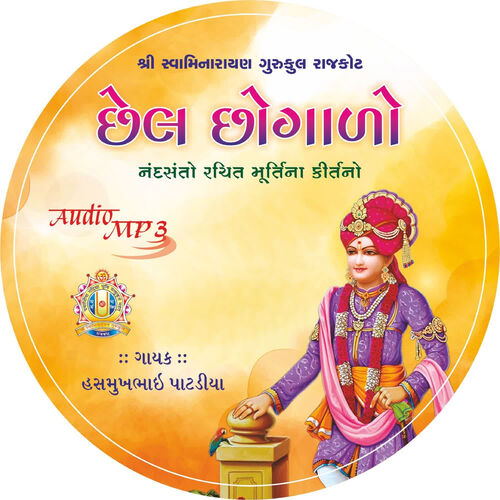

Through the inspiration of Bhagwan Shree Swaminarayan, and the power of Bhuj Saints and Bhaktos from all over the world, a magnificent temple has been constructed using traditional Vedic architectural methods, on the banks of Hamirsar Lake. The Uniqueness of the Swaminarayan Fellowship It was collaboratively resolved to construct this new temple a short distance away from the original site. However after a mutual agreement between Acharya Maharajshree, Saints and the devotees from all corners of the globe and given the circumstances of the irreparable damage to the original temple building, it was decided that the idols would be housed inside a new grand temple.

Miraculously the divine idols remained as they were, without any damage whatsoever.

The Gujarat Earthquake of January 2001 destroyed much of the city of Bhuj, including the side of the temple facing north which was built by Lord Shree Swaminarayan. Roop Chowki, the main square of the inner temple housed the images of Ganapati bapa and Hanumanji. Lord Shree Swaminarayan had graced this temple in the western belt of India and had Himself installed the idols of Narnarayan Dev on (VS 1879 Vaisakh sud 5) and later Acharya Shree Ayodhyaprasadji Maharaje installed Hari-Krishna Maharaj on 06 March 1867 (VS 1923 Fagan sud 2).īesides these, manifestations of the Lord at the central dome, under the eastern dome were seated Radha-Krishna Dev, Hari-Krishna Maharaj and under the western dome Ghanshyam Maharaj. They executed the plans with every minute detail taken into account and within a short span of one year, on 15th May 1823, the Murti's were installed by Lord Shree Swaminarayan. Vaishnavananand Swami and the accompanying saints went to Bhuj in 1822 and drew up plans for the original Bhuj temple. So Lord Shree Swaminarayan asked Vaishnavananand Swami to proceed with a team of saints to Bhuj and construct a temple. The Lord was pleased and more than happy to fulfil the wishes of His devotees. During the festival devotees from Bhuj met Lord Swaminarayan and requested him to construct a temple in Bhuj. Senior devotees Gangarambhai, Sundarjibhai and others from the Bhuj went to Gadhada where Lord Shree Swaminarayan was attending the famous fuldol festival.

This divine thought of Bhagwan Shree Swaminarayan alone signifies the vast amount of spirituality the land of Kutch offered not only in the past but even today. Such Bhaktos of Kutch included Ladhiba, Sundarji Suthaar, Gangaram Mall from Bhuj, Khaiyo Khatri of Mandvi, Sadaba of Kera, Adabhai, Mulji and Krishnaji all of Manukva, Karniba of Dhamadka, Saamat Sarvaiya of Rapar, Vaghasha of Bhachau and many more.īhuj is one of the six places where Lord Shree Swaminarayan constructed the temple Himself.
#SWAMINARAYAN BHAJAN SERIES#
As a result of His frequent visits, a series of inspirational devotees realised that He was none other than the Supreme Purshottam Narayan Himself. He spent 30 years of His total lifespan in Gujarat and visited Kutch more than 20 times (His total time spent in Kutch was 7 years). After his appointment as the spiritual leader of the whole Sampraday, He visited Kutch in the month of Maha Sud 7 Samvat 1860. Lord Shree Swaminarayan was always attracted by the divine attributes of the devotees of Kutch. Later volumes will cover further stanzas.Mahima of Lord Shree Swaminarayan and the devotees of Kutch The scripture “Karo Bhajan Sahu Part 1”, authored by Acharya Swamishree Mahraj, discusses at length, three of the sixteen stanzas of Bhaj Govind, elucidating it using the Vachanamrut and Bapashree ni Vato scriptures, and the teachings of Jeevanpran Swamibapa. Many scholars consider this composition as the most important, brief and simple substance of all Vedantic thought. The famous scholar, Shankaracharya wrote a multi-stanza stotra, or prayer, called “Bhaj Govind”, in which he emphasises the importance of devotion for God as a means to spiritual development and liberation from the cycle of birth and death. This pre-eminence of ‘bhajan’ is précised by Gurudev Jeevanpran Shree Muktajeevan Swamibapa in His kirtan, ‘Karo bhajan sahu’ from which this new scripture takes its title. It is said the one should cast aside a hundred other tasks when it is time to eat leave a thousand tasks when it is time to bathe put aside a hundreds of thousands of other activities and instead donate to the Lord but one should cast aside tens of millions of other tasks in order to perform devotion to, and in praising, the Lord. The importance of devoting to and praising (bhajan) the Lord is unsurpassed.


 0 kommentar(er)
0 kommentar(er)
